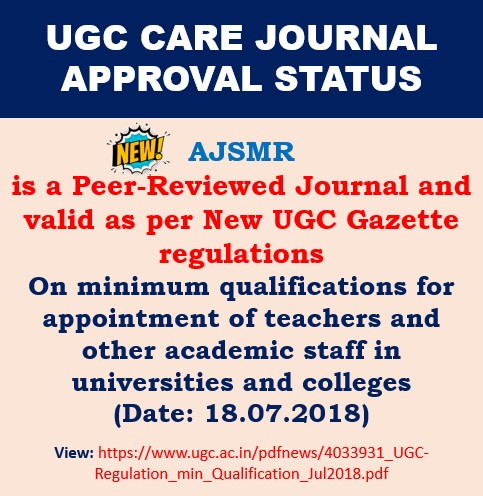Original Research Article I Volume 3 I Issue 1 I 2017
Evaluation of Antioxidant activity of commonly consumed Fruits of South India
Ravulakolanu Vanisree, Madhu Kamarapu, Veenavani Marka and Prameela Devi Yalavarthy
American Journal of Science and Medical Research; 3(1); 10-14
DOI:http://dx.doi.org/10.17812/ajsmr3103
Abstract:
Consumption of natural foods play important role in preventing health disorders due to oxidative stress caused by free radicals. Fruits are the major ingredients in the Indian diet. However, information on the antioxidant activity of fruits used in Indian diet is inadequate. The main objective of this study is to evaluate the antioxidant activity of some commonly used fruits by Indians such as Manilkara zapota (Sapota), Carica papaya (Papaya), Musa acuminate (Banana) and Psidium guajava (Guava). Antioxidant activity is assessed by DPPH (2,2-diphenyl-1-picryl-hydrazyl) and HRSA (Hydroxyl radical scavenging activity) methods. The present study revealed that the crude methanol extracts of Psidium guajava (Guava) showed the maximum scavenging activity, where as Musa acuminate (Banana) showed minimum scavenging activity in both DPPH method and in HRSA methods. Scavenging activity of selected fruits revealed that regular usage of Psidium guajava is better than Carica papaya, Manilkara zapota and Musa acuminate in descending order, in the regular Indian diet to overcome the effects of free radicals and be healthy
Keywords:
Antioxidant activity, DPPH method and Hydroxyl radical scavenging activity, Methanol, fruits.
References:
[1]. Adam Matkowski and Magdalena Piotrowska,2006, Antioxidant and free radical scavenging activities of some medicinal plants from the lamiaceae, Fitoterapia., Vol 77(5).,pp: 346-353
[2]. Carolina Santos, Goreti Botelho, Ilda Caldeira, Amílcar Torres and Fernanda M. Ferreira.(2014) Antioxidant activity assessment in fruit liquors and spirits: methods comparison. Journal of Viticulture and Enology, Vol.29(1), pp. 28-34.
[3]. Cespedes C.L., Valdez-Morales M., Avila J.G., El-Hafidi M and larcon J., Paredes-Lopez O.(2010). Phytochemical profile and the antioxidant activity of Chilean wild black-berry fruits, Aristotelia chilensis (Mol) Stuntz (Elaeocarpaceae). Food Chem.,vol.119, pp. 886- 895.
[4]. Davies, K.J.(2000) Oxidative Stress, Antioxidant Defenses and Damage Removal, Repair and Replacement Systems. IUBMB Life, Vol.50, pp. 279-289.
[5]. Frei B (1991) Ascorbic acid protects lipids in human plasma and low-density lipoprotein against oxidative damage. Am. J. Clin. Nutr. Vol.54, pp. S1113–S1118.
[6]. Huang W.,Zhang H and Liu W., Li C., (2012). Survey of antioxidant capacity and phenolic composition of blueberry, blackberry and strawberry in Nanjing. J. Zhejiang University – SCIENCE B, Vol.13, pp. 94-102
[7]. Juliana Cristina Pereira Calado , Paula Adriana Albertao, Erica Aparecida de Oliveira, Mario Henrique Sisto Letra, Alexandra Christine Helena, Frankland Sawaya and Maria Cristina Marcucci.(2015). Flavonoid Contents and Antioxidant Activity in Fruit,Vegetables and Other Types of Food. Agricultural Sciences,Vol.6, pp. 426-435
[8]. Lim BP, Nagao A, Terao J, Tanaka K, Suzuki T and Takama K (1992): Antioxidant activity of xanthophylls on peroxyl radical mediated phospholipid peroxidation. Biochim. Biophys. Acta, Vol.1126, pp. 178–184.
[9]. Liu M., Li X.Q., Weber C., Lee C.Y., Brown J and Liu R.H.,(2002). Antioxidant and antiproliferative activities of raspberries. J. Agric. Food Chem.Vol.50, pp. 2926-2930.
[10]. Oliveira A.C., Valentim I.B and Goulart M.O (2009). Vegetables as natural sources of antioxidants. Química Nova, Vol.32, pp. 689-702....
Article Dates:
Received: 2 February 2017; Accepted: 21 March 2017 ; Published: 29 March 2017
How To Cite:
Ravulakolanu Vanisree, Madhu Kamarapu, Veenavani Marka and Prameela Devi Yalavarthy (2016). Evaluation of Antioxidant activity of commonly consumed Fruits of South India. The Ame J Sci & Med Res, 3(1):10-14.. doi:10.17812/ajsmr3103.



